A Narrative of the Visionary Path
The below article should shed some light on the plethora of past ingredients that make Delilah who she is.
Early On: The 70’s
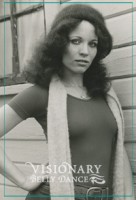 Delilah was swim team captain at Grossmont High School in La Mesa, CA. The rest of the year she enjoyed Hatha Yoga classes with her mother. She graduated from high school a year early with a trade school degree in cosmetology, which she planned to use to work her way through collage. For her first semester courses she took art, women’s studies and logic. She loved school but life had another plan for Delilah. At age 18, she took a belly dance class that would set the course for a unique life of cultural diversity, dance and performance art. The class was offered as an adult education course taught by Scheherezade (Grossmont College San Diego area of CA).
Delilah was swim team captain at Grossmont High School in La Mesa, CA. The rest of the year she enjoyed Hatha Yoga classes with her mother. She graduated from high school a year early with a trade school degree in cosmetology, which she planned to use to work her way through collage. For her first semester courses she took art, women’s studies and logic. She loved school but life had another plan for Delilah. At age 18, she took a belly dance class that would set the course for a unique life of cultural diversity, dance and performance art. The class was offered as an adult education course taught by Scheherezade (Grossmont College San Diego area of CA).
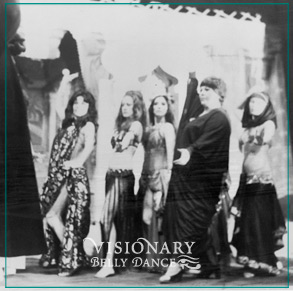 Belly dance had become an American phenomena in the early 70’s. At the college there were 4 classes offered with 35 women in each class and tons of women turned away in the pouring rain on registration night. You couldn’t get credit for the class at the time, but low and behold, this would be the class that led to a fabulous life and productive career. Delilah was mesmerized from day one. It was all she could think about. She practiced 3 times a day. She was taught a style that would come to be known as Classical American style. It was a belly dance rapport culled from many traditional ethnic influences and strained through American culture; dappled with cliche images of exotic times and places brought to us from Cecil B. DeMille movies and “I Dream of Jeannie”. Delilah was a young American woman and from a generation of peace, love, bra burners, women’s libbers and the magic birth control pill. In this day, more women could postpone families, go to collage and choose careers over diapers if they wanted. She was hot to lead and design her own life.
Belly dance had become an American phenomena in the early 70’s. At the college there were 4 classes offered with 35 women in each class and tons of women turned away in the pouring rain on registration night. You couldn’t get credit for the class at the time, but low and behold, this would be the class that led to a fabulous life and productive career. Delilah was mesmerized from day one. It was all she could think about. She practiced 3 times a day. She was taught a style that would come to be known as Classical American style. It was a belly dance rapport culled from many traditional ethnic influences and strained through American culture; dappled with cliche images of exotic times and places brought to us from Cecil B. DeMille movies and “I Dream of Jeannie”. Delilah was a young American woman and from a generation of peace, love, bra burners, women’s libbers and the magic birth control pill. In this day, more women could postpone families, go to collage and choose careers over diapers if they wanted. She was hot to lead and design her own life.
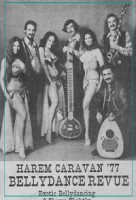 In contrast to her daily American life style, Delilah became more immersed in belly dance culture. She cut her teeth as a baby dancer working with Middle Eastern musicians like Antoine Hage, Frank Oraha, George Kahyat, Maroon Sabah, Richard Barham, Harry Saroyan. They introduced her to the ethnic food, families, music, language, customs, religions from many different cultures that were all new, fascinating and often very conservative to her. The communities were warm and friendly, however she always felt a bit like an odd duck around these people because she was a belly dancer. There was definitely a double standard operating. One minute they were bragging about the belly dance stars they new and loved from the old country and the next they were saying, “But not my daughter or daughter in law!” Bigotry from the cultures that American belly dancers were praising for being the dance’s origins, caused mixed feelings.
In contrast to her daily American life style, Delilah became more immersed in belly dance culture. She cut her teeth as a baby dancer working with Middle Eastern musicians like Antoine Hage, Frank Oraha, George Kahyat, Maroon Sabah, Richard Barham, Harry Saroyan. They introduced her to the ethnic food, families, music, language, customs, religions from many different cultures that were all new, fascinating and often very conservative to her. The communities were warm and friendly, however she always felt a bit like an odd duck around these people because she was a belly dancer. There was definitely a double standard operating. One minute they were bragging about the belly dance stars they new and loved from the old country and the next they were saying, “But not my daughter or daughter in law!” Bigotry from the cultures that American belly dancers were praising for being the dance’s origins, caused mixed feelings.
This particular issue is at the heart of many of the ways in which Delilah’s career took shape. Either Delilah had to say she was doing the dance of a harlot or she had to call bullshit on these attitudes. After 30 years of experience, she has come to the conclusions that no one culture owns belly dance. The heart of this dance belongs to women. They are the ones who get what it is. This dance is passed along from generation to generation and if there’s not an ounce of belly dance heritage in your cultural heritage, then it can still be locked in our very DNA. It was reawakened at a time when America was speaking to freedom for women. A rich soil for it’s new evolution. In the next 30 years, belly dance grew in America and Delilah would grow to become a vital part of shaping it.
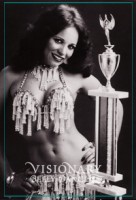 Delilah went on within her second year of study to win contests. She entered one for a brand new car in which she placed second. In 1977, she won the title of Belly Dancer of the Year in the annual Walnut Creek California contest, originally started by Sula. (She would later win this title again in 1997, as presented by IAMED.) In those days, Delilah danced nightly mostly with traditional Arabic music ensembles. Dance sets were some times 45-55 minutes long! Then her new found career took all sorts of directions at once.
Delilah went on within her second year of study to win contests. She entered one for a brand new car in which she placed second. In 1977, she won the title of Belly Dancer of the Year in the annual Walnut Creek California contest, originally started by Sula. (She would later win this title again in 1997, as presented by IAMED.) In those days, Delilah danced nightly mostly with traditional Arabic music ensembles. Dance sets were some times 45-55 minutes long! Then her new found career took all sorts of directions at once.
First, she became the feature attraction in the Harem Caravan Revue at the Ramada Inn (Hotel Circle, San Diego). It was theatrical in staging and it was there, working with Richard Barham and Dave Dhillion, the true show biz polish was applied 5-6 nights a week, 2-3 shows nightly. Richard gave dancers permission to be inventive with their routines and Delilah came up with a dance she called the “Cane Dance of the Ancient Pharaoh” that she performed nightly. Each dancer did a 15-20 dance set. The audience changed after each show.
Second she also became involved in a tribal/folkloric troupe called Asmoroni directed by Rossa Galab, a protege of Jamilla Salmipour. She learned choreography and got some folkloric experience. They worked the Descanso Pleasure Faire for an enchanting month.
Third she started guest appearing in New Port Beach at the Apadona Club with John Bilezikjian, Var Dagdevarian and Aziz Katra. John Bilezikjian is a virtuoso on the oud (you have heard him a hundred times on movie sound tracts). He introduced her to new songs from many different lands. The club had a motorized stage that came out from under the bands stage so the audience could see the dancer perfectly during the floorwork section.
Delilah also worked for a few months at a Greek Club in La Jolla, CA called Athens West. It was very upscale and featured dancing waiters. The live Greek music came in from Chicago and she was introduced to the bazookie. The dance floor was in the center of the room surrounded by floor lights and Greek statues. It was here she learned to spin and do the famous Turkish Drop.
Delilah’s success was a growing phenomenon and she began being featured on the covers of all the belly dance magazines. Articles appeared on her exploits as well as her own writing from time to time. She began teaching at Radiance Yoga & Dance owned by Leo and Kathreen in San Diego. She taught women and children.
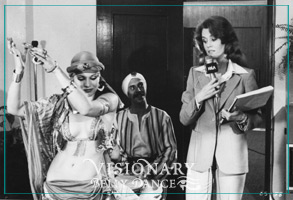 Delilah soon moved on to Hollywood where she innovated the first bellygram for the Live Wires Company that became a popular favorite with the rich and famous. Instead of a singing telegram, it was a belly dance message. This led to an appearance in the movie China Syndrome with Jane Fonda, Jack Lemon and Michael Douglas. Before the movie was out in 1979, she was shanghaied by love to the Northwest where she began a family with Rock and Roll musician, Steven Flynn, and her 25 years of entrepreneurship. (Side note: The movie was about a nuclear power plant melt down and 2 weeks after it was released an actual melt down at 3 Mile Island in PA happened changing the future of the Nuclear Power industry. Delilah is in the first 5 minutes delivering an abbreviated belly gram.)
Delilah soon moved on to Hollywood where she innovated the first bellygram for the Live Wires Company that became a popular favorite with the rich and famous. Instead of a singing telegram, it was a belly dance message. This led to an appearance in the movie China Syndrome with Jane Fonda, Jack Lemon and Michael Douglas. Before the movie was out in 1979, she was shanghaied by love to the Northwest where she began a family with Rock and Roll musician, Steven Flynn, and her 25 years of entrepreneurship. (Side note: The movie was about a nuclear power plant melt down and 2 weeks after it was released an actual melt down at 3 Mile Island in PA happened changing the future of the Nuclear Power industry. Delilah is in the first 5 minutes delivering an abbreviated belly gram.)
Her Big Break; The 80’s
In the 80’s the VCR came into homes. Soon special interest video technology become within the financial reach of artists to produce their own media projects instead of having to relying on big production companies. The trouble with main steam production was the dictation of content and the slant of your message. Delilah didn’t want to deliver their message. She wanted to talk directly to the women who already new about belly dance, not some “how to dance for your husband” twist.
A popular musician named Raja Zahr choose Delilah to be a featured dancer to illustrate his modern belly dance music collection. The video was called Dance Illusion and brought Delilah’s sensuous and dramatic style into thousands of living rooms across the nation. She also was the feature in a fever pitched performance with the band, TransArabian Sound on a video called “Festival of the Nile” in Orlando FL. It was a fundraiser for the Leukemia Society. These two videos, with the release of her own instructional video set, made her a household word in the special interest world of belly dance in America and shortly all over the world as her videos were offered in the PAL format. Many countries pirated her works, bumping her familiarity and allowing her to inspire women in all different lands.
Visionary Years; The 90’s
Delilah became known as the Visionary Dancer in the 90’s. This was partly because to facilitate her instructional belly dance video series, she ran into a music road block. She had applied for music rights for some of her favorites and the companies responses were so outrageous, they were basically saying “no”. This was very frustrating. She needed to own the copyright to the music to be able to produce her first instructional belly dance series. Her composer husband Steven Flynn was glad to oblige. They were not forsaking their love and respect for traditional Middle Eastern music, but Delilah and Steve were truly creative artists. Delilah is also a feminist, and felt the departure from traditional music would give her the opportunity to make a point; today’s belly dance was not dependent on one kind of music or back drop of any one culture. She felt belly dancers needed to take pride in their own artistic voice instead of passing credit to cultures that were a little messed up on the idea, especially cultures that didn’t have a track record for recognizing women’s rights. Middle East, Near East, Far East are all a part of the dance, but do not own it. The American pursuit and resulting artistic development of the belly dance was totally related to the amount of freedom American women enjoy, thus the reason belly dance exploded in America in the 70’s. Like Raja and a handful of other musicians around the country, Steven Flynn seized the opportunity to create new music. Visionary Dance used the words “Contemporary Belly Dance Instruction” instead of “Middle Eastern”. Over the early years Visionary Dance produced 4 music projects; Tales of the Night Wind, Welcome to the Dance, Inner Dances and Rapture Rumi. It was grounded by simple rhythms of the Mideast but free to employ new soul inspired melodies encouraging a new chapter in belly dance music and dance. We see it everywhere today.
Branching Out in Seattle
In Seattle, she was a featured performer in the Arabic and Greek night club scene, namely the Grecian Corner (1978-89). Off hours, she was cultivating a new energy by taking her dance vocabulary and connecting with local African drummers and close knit women’s drum circle. These drum circles were starting to be popular in the women’s spirituality movement in America. It was in these women’s circles she met Sarah Teofanov and Michelle Seville, both Seattle artists. Delilah attributes her personal growth of understanding of what it means to be an artist to her connection with them. She joined Seattle’s Women of Wisdom and pursued, like many women across the country, a new kind of women’s spirituality that warmly welcomed the dance. Thus began a chapter to contrast her ethnic night club experience. Delilah began exploring the use of belly dance as performance art in settings such as museums, galleries, community gatherings, theaters and church. She began collaborating closely with artists of other mediums. “Faces of the Mother; Phases of the Moon” involved four dancers, a composer and a visual artist using belly dance and Goddess archetypes. In this piece, Delilah was very pregnant and her piece “Dance To the Great Mother” gave birth to the basis of the visionary years.
Multimedia Collaborations and World Peace
This work also led to a major collaboration that would span continents. “Calling up the Oracle,” a performance work that involved artist and ritualist Sarah Teofanov, composer Steven Flynn and Delilah, was originally commissioned for presentation at Washington State University, in Pullman, Washington and performed in a gallery setting. A second off shoot of this work followed called “Calling up the Oracle for Peace” involved workshops where women in Seattle and Tashkent would sew on a cooperative peace blanket while drumming, dancing, chanting and visualizing world peace. These sessions were recorded and woven into the sound tract for the theater performances. The piece used ritual, art props, shamanism, cathartic trance dance, nature sounds, and the women chanting for peace in multiple languages. It was part of an artists’ for peace exchange headed by Dr. Laurel Victoria Gray and her work with the Seattle/Tashkent Sister City Committee. It has been performed multiple times in the U.S. and was then taken to the then Soviet Union and performed for 2 sold out nights at the famous Ilkhom Theater. The delegation was one of the first to be allowed to stay in the homes of local citizens instead of the KGB Hotels. It was an exciting time. Within months of their visit, the Berlin wall came down, bringing huge historic changes.
This work also led to a major collaboration that would span continents. “Calling up the Oracle,” a performance work that involved artist and ritualist Sarah Teofanov, composer Steven Flynn and Delilah, was originally commissioned for presentation at Washington State University, in Pullman, Washington and performed in a gallery setting. A second off shoot of this work followed called “Calling up the Oracle for Peace” involved workshops where women in Seattle and Tashkent would sew on a cooperative peace blanket while drumming, dancing, chanting and visualizing world peace. These sessions were recorded and woven into the sound tract for the theater performances. The piece used ritual, art props, shamanism, cathartic trance dance, nature sounds, and the women chanting for peace in multiple languages. It was part of an artists’ for peace exchange headed by Dr. Laurel Victoria Gray and her work with the Seattle/Tashkent Sister City Committee. It has been performed multiple times in the U.S. and was then taken to the then Soviet Union and performed for 2 sold out nights at the famous Ilkhom Theater.
Delilah also performed her belly dance. She actually performed 19 times in 14 days. Because of the nature of how things were run behind the iron curtain, the dancers in Taskent knew ballet and Central Asian dance but when it came to belly dance, which is totally associated with their Turkic roots, they were some how cut off. They loved Delilah. They called her the “Yellow Dress” after seeing her perform for the first time. It was in a theater stage in the largest theater Delilah had even performed in. People would holler from the audience “We want to see the Yellow Dress!” It was exciting and new for them and they spread the word. Delilah received a special invitation to perform in the world class renown Tashket Circus. Since she danced bare foot, they canceled the animal acts for that evenings performance.
The 28 member American delegation was comprised of theater workers, actors, Central Asian dance students, a trapeze artist, a visual artist and 2 belly dancers. They were the first groups allowed to stay in the homes of local citizens instead of the KGB Hotels. It was an exciting time of change. Within months of their visit, the Berlin wall came down, bringing huge historic changes.
Further Influences and “The Turn”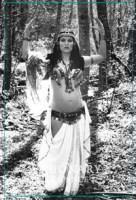 Delilah was influenced by the visionaries of the day as well women’s studies writers such as Dr. Jean Shinoda Bolin, MD (Goddess in Every Woman), self proclaimed witch Starhawk (Spiral Dance), Joseph Campbell (Power of Myth), Deepak Chopra and Shakti Gawaines’ creative visualization, Maya Deren’s “Divine Horsemen” and her early film works, Ruth St Denis poetry and dance, Carl Yung’s synchronistic psychology and symbolism, Coleman Bark’s Rumi poetry translation, Leonard Shalan, Diane Wolkstien’s Sumerian translations of Inanna, Mathew Fox to name a few. For her nature studies, naturalist Rupert Sheldrake’s Morphogenic Field Theory, Robert Lawlor’s Aboriginal studies, Hazrat Inyat Kahn’s nature notes, Dora Kuntz’s healing touch and talks about nature spirits inspired her.
Delilah was influenced by the visionaries of the day as well women’s studies writers such as Dr. Jean Shinoda Bolin, MD (Goddess in Every Woman), self proclaimed witch Starhawk (Spiral Dance), Joseph Campbell (Power of Myth), Deepak Chopra and Shakti Gawaines’ creative visualization, Maya Deren’s “Divine Horsemen” and her early film works, Ruth St Denis poetry and dance, Carl Yung’s synchronistic psychology and symbolism, Coleman Bark’s Rumi poetry translation, Leonard Shalan, Diane Wolkstien’s Sumerian translations of Inanna, Mathew Fox to name a few. For her nature studies, naturalist Rupert Sheldrake’s Morphogenic Field Theory, Robert Lawlor’s Aboriginal studies, Hazrat Inyat Kahn’s nature notes, Dora Kuntz’s healing touch and talks about nature spirits inspired her.
She was involved and inspired by Sufi dances of Universal Peace and the dance shaman Gabriel Roth, hand drumers Layne Redmond and Semone La Drum. She dabbled in Tai Chi and Buddhist chanting. In 1994, she joined the Mevlevi Order of America, whirling dervishes, and studied “the turn” with Sheik Jelaleddin Loras and Scott Hoffman. She loved to turn and she loved the natural symbolism behind all the rituals. She sought this call because she wanted to find the spiritual origins within dance. There is nothing written in regard to belly dance so she had to explore other old world movement practices to glean wisdom she could apply to her belly dance.
When it comes to history of the dance, Delilah’s insight concludes that usually the dancers are dancing not writing. Belly Dance is a language of its own. Her involvement with the dervishes lead her to be featured in the book, Women Called to the Path of Rumi by Shakina Reinhertz. In 1997, she accompanied her sheik to Konya Turkey and turned inside Rumi’s Tomb in a sacred rite known as the Sema. It was a hallmark event to get permission to turn inside the sanctuary as a woman. A clip is featured on her website. In the year 2001 she had a falling out with some of the brethren of the organization and left because of feelings of disenfranchisement over a head scarf argument. The argument was not with Sheik Jallaladine. He and Delilah remain good friends.
Delilah had been a award winning swimmer and always wanted to do a belly dance underwater. In the 1991, she and Steve set out to record a video dance into the sea on a beach in Maui. As she swam out to sea at dawn she had an epiphany. She had to bring other dancers to experience the magical connection of dancing the belly dance into the warm ocean surf at sunrise. It made an organic primordial connection, bringing deeper meaning to the dance as it connects to belly, womb and all life. Before the first retreat group met at Mana Lea Gardens on Maui, she realized she also needed live music. Thus began a long and beloved relationship with the magical musical duo Sirocco. They have been featured at 20 of her retreats plus 4 of her tours.
Not only did that first dance into the sea lead to her amazing retreat legacy that continues today, but it opened her up to another new exploration in belly dance: Belly Dancing in the Natural World. We think of dance as performance, but this was more personal, psychic, meditative. It was belly dance communion. She mounted expeditions into the jungles of Hawaii, Costa Rica and the forests of the Northwest. She and her dancers, along with musicians and drummers would not stop with just her Ritual Dance into the Sea each January. She led them into waterfalls, to windy bluffs, in tide pools, in mossy rain forests, in bottomless lakes, around active volcanoes, sacred sites, on foggy morning and desert sands, and even under water (see Underwater gallery). Over the years, Delilah furthered her understandings of meaning and methods, then delivered a paper on “Dancing in the Natural World” to the International Belly Dance Conference in OCC in Costa Mesa CA, 1997.
Her retreats created opportunity for herself, and the dancers who attend, to glean wisdom in ways that are truly extraordinary. The nature of retreat can be life changing for people. Combine this with the dance and the dance adventures in intimate and magical settings and you have an experience of a life time. Each year features a different guest star, theme and maybe style of belly dance. Find out more about current retreats Here >>
Turn Of The Century
In September of 2001, two American airliners crashed into the World Trade Center, one into the Pentagon and one into a field in Pennsylvania and major changes came to America and the belly dance world. People thought belly dance would suffer by a backlash on anything Middle Eastern, but oddly enough, it was the opposite. Interest in belly dance surged in America. It was a sign that by 2001, belly dance had finally become recognized as part of American culture. “Everyone knew a belly dancer now a days,” says Delilah. “Somebody’s mother, sister, daughter or nephew.”
As belly dance went through another big popularity resurgence, Delilah road the wave creating more programs, tours and retreats. Her next big move was to reveal her secret training tool, the Power Belly, Belly Dance Weight Belt. See Innovations for the whole story!
After 2001, lots of new dancers entered the scene. American Tribal got very popular, and by 2003 the Belly Dance Super Stars manifested as a touring show world wide. Delilah put together an East Coast Caravan Tour of 15 cities with musical duo Sirocco. It was also the debut of her daughter, Laura Rose (say the whole thing or she’ll correct you), who was beginning her dance career. Delilah brought the use of her Power Belly Dance and weight belt training. In 2004, she opened her own exclusively belly dance VDP Studio in Seattle. It was a dream come true after all these years to have her own dance temple. She gutted a building and made it to facilitate classes and performance, video production, a merchandise show room, and is the head quarters for her online business.
Belly dance contests came back into popularity and Delilah often facilitated as a judge. She accepts these invitations because she loves to watch dancers, even though she doesn’t really think we need to compete. She feels competition can lead to divisiveness, but she leaves that decision up to the individual dancer.
One thing Delilah is well known for all her career is her love and undying support for live music. She always strives to bring live music into most everything she does but it has always been an important aspect of her retreats as well. In the past, she’s worked most often with John Bilezikjian, Steven Flynn, Sirocco, Michael Beach and Brothers of the Baladi. She’s also had Jeremiah Soto of Solace to her retreats and sponsored in the Northwest.
In 2004, Delilah began working with a group of traditional Arabic musicians again. It was at a rehearsal with her they choose the name, donned their fezzes and tuxedo and began the first recording project that Delilah co-produced. They are known as House of Tarab.
The Visionary Call…Again
Back in 2002, Delilah had announced that she had a new name and vision for the dance group she had been calling the Visionary Dancers since the early 90’s. She wanted to call it the Neighborhood Temple Priestesses and maybe eventually a group called the Goddess Scouts of America. She realized that after all these years of dancing, her ideas had matured. Way back, she learned the value of how belly dance empowers women’s lives. Now a new wisdom has arrived, “Yes, belly dance empowers our lives, AND the lives of our family and greater community.” Her quest is to create awareness to the general public to recognize the art of belly dance as important, powerful and valuable for all. How? By becoming involved with community and becoming a valuable resource; to present the dance in a way that moves hearts sometimes to tears as they help community vivify the most important transitional times in our lives through dance, art and women’s wisdom. What are these times? The seasonal changes, birthdays, maternity, retirement, loss, gains, mentorship, marriage, divorce, new projects and ground braking, house blessings, memorials, conflict resolution, holidays, and traditions of all kinds: Call on the Neighborhood Temple Priestess.
The Neighborhood Temple Priestess took official hold in the fall of 2008. In that year they have done so much in so many ways. They worked with a program furthering belly dance as a therapy for postpartum depression, they built indoor and outdoor art installations for people to dance in, they marched for Single Payer health insurance and raised money for NARAL, Sofia Center for Homeless Women, The Abby Arts Center. They held outreach to women in need that were suffering from miscarriages, depression, illness and injury. They gave belly dance baby and wedding showers, and performed at a wedding, assisted living facilities and a memorial. They took in an intern for her high school class project. They taught NTP classes involving our skills, they made handmade products to support the VDP overhead.
2010
Delilah’s days are filled with managing and teaching in her studio, putting the Power Belly Show up each week, directing the Neighborhood Temple Priestess, dreaming new projects, traveling to do workshops, retreats and concert performances. She hopes to find more time to write. Her new blog feels like it will be a fun new experience. Delilah’s goals are to mentor, assist, and promote new dancers and musicians she feels hear the call of what it means to be an artist. If she can help, she wants to give them a step up! She feels it is her post in life is to constantly give women permission to be whole; body, emotion, mind and soul. Seems silly someone has to give them permission, but if they need to hear it, she is here to give it to them.
2010-18
House of Tarab with tabla player Erik Brown
Delilah is a featured dancer with House of Tarab since 2004 (a 5-6 piece Middle Eastern Ensemble). They produced two stunning albums in that time.
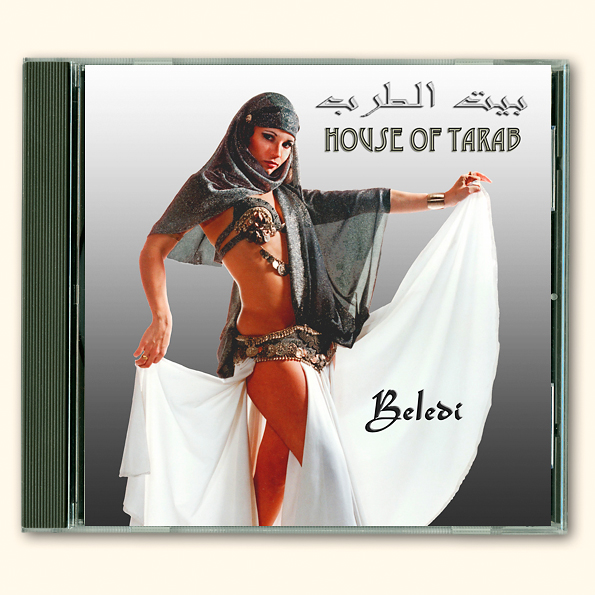

Delilah & House of Tarab presented intimate house concerts monthly and are available to perform for festivals and private parties.
In addition she teamed up professionally and personally with tabla player Erik Brown, Together they traveled; Hawaii, Korea, Canada, Egypt, & the States. He provided live music and percussion for her Power Belly live Workshops. Erik & Delilah taught a special course together “Between a Dancer and a Drummer”, a popular dancers drum solo course. Mr. Erik and Delilah made a great team together with a special spark. The Seattle dance community knows them well.
In 2018 Erik Brown suddenly passed away leaving a huge hole in the dance communities heart as well as Delilah’s and the bands.
2019
Delilah is being featured in an up coming documentary about the pioneer Icons in Belly Dance through the 70’s-present produced by Amaya Productions and set to be released internationally this year. She performs with H.O.T, teaches private lessons and occasional workshops and lectures. There is talk of a future belly dance retreat (dates TBA. contact to be alerted). Always working on her memoirs encompassing over 45 years of visionary belly dance.
Delilah’s goals are to mentor, assist, and promote new dancers and musicians; that she feels hear the call of what it means to be an artist. If she can help, she wants to give them a step up! She feels it is her post in life is to constantly give women permission to be whole; body, emotion, mind and soul. Seems silly someone has to give them permission, but if they need to hear it, she is here to give it to them.
